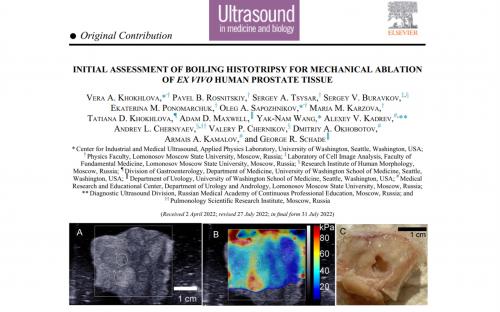The LIMU team has published a paper on histotripsy liquefaction of ex vivo human prostate tissue in a top-rated journal Ultrasound in Medicine and Biology (Q1)
A paper entitled «Initial assessment of boiling histotripsy for mechanical ablation of ex vivo human prostate tissue» has been published in a top-rated ultrasound in medicine and biology journal (Q1, IF 3.694). The study came as a result of joint efforts of a multidisciplinary team, which included LIMU fellows (Khokhlova V.A., Rosnitskiy P.B., Tsysar S.A., Ponomarchuk E.M., Sapozhnikov O.A., and Karzova M.M.), physicists, and medical doctors from different institutions. The co-authors were affiliated with the Faculty of fundamental medicine of MSU, Medical Research and Educational Center of MSU, the Research Institute of Human Morphology, and the University of Washington.
The study assessed the feasibility of using boiling histotripsy (BH) method to ablate fresh ex vivo human prostate tissue as a proof of principle for developing BH for prostate applications. BH is a focused ultrasound technology that results in mechanical tissue ablation almost without thermal effects.
The experiments were performed for a set of 24 fresh human prostate samples obtained via rapid autopsy. Samples were analyzed using shear wave elastography to ensure that mechanical properties of autopsy tissue were clinically representative. The samples were exposed to BH using shorter and longer (10- or 1-ms) pulses under real-time B-mode and Doppler imaging. Tissue then was evaluated grossly and histologically, and the lesion content was analyzed using transmission electron microscopy and scanning electron microscopy.
As a result, it was demonstrated that BH is feasible in fresh ex vivo human prostate tissue producing desired mechanical ablation. Histological analysis and electron microscopy revealed lesions containing completely homogenized cell debris, consistent with histotripsy-induced mechanical ablation. BH treatment was twofold faster using shorter pulses (1 ms vs. 10 ms).
The study supports further work aimed at translating BH technology as a clinical option for prostate ablation, in particular, for the case of localized prostate cancer.

